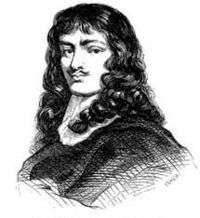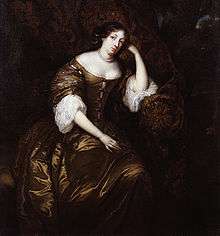Sir William Temple, 1st Baronet


Sir William Temple, 1st Baronet (25 April 1628 – 27 January 1699) was an English statesman and essayist.
Biography
William Temple was the son of Sir John Temple of Dublin and nephew of Rev. Dr. Thomas Temple DD. Born in London, and educated at Emmanuel College, Cambridge,[2] Temple travelled across Europe, and was for some time a member of the Irish Parliament, employed on various diplomatic missions. During his time as a diplomat, Temple successfully negotiated the marriage of the Prince of Orange and Princess Mary of England, and the Triple Alliance of 1668. On his return he was much consulted by Charles II, but disapproving of the anti-Dutch courses adopted, retired to his house at Sheen.[3]
He was called out of retirement to implement a plan of his design to reform government rule. He was the architect of the Privy Council Ministry, which, though it failed, was an early effort to establish an executive along the lines of what later came to be understood as Cabinet government. Charles II disapproved of the scheme, which in his view took away too much of the Royal Prerogative, although in the exceptional circumstances of the Exclusion Crisis he was willing to give it a brief trial.[4]
Temple later left Sheen and purchased Compton Hall, Farnham. He renamed the house Moor Park after Moor Park, Hertfordshire, a house he much admired and which influenced the formal gardens he built at Farnham. Here the later-famous Jonathan Swift was his secretary for most of the period from 1689 onward.[5] It was here that Swift met Esther Johnson, who became his lifelong companion and whom he immortalised as Stella.[6] Despite rumours that she was Temple's own daughter, the evidence suggests that her widowed mother lived in the house as companion to Temple's sister Martha. Temple installed his family motto "God has given us these opportunities for tranquility" above the door and took great pleasure from this house in his retirement from public life.[7]
He took no part in the Glorious Revolution, but acquiesced to the new regime, and was offered, but refused, a role as Secretary of State.[3]
Temple died in Moor Park, Surrey, England in 1699.[3] A memorial was erected to him in Westminster Abbey and to his wife Dorothy and daughter Diana; in 1722 the name of his sister Martha was added. He was much loved by his friends; Swift wrote that all that was good and amiable in mankind departed with him.[8] The normally cynical Robert Spencer, 2nd Earl of Sunderland, was deeply grieved, writing to Temple's sister Martha that " the chief pleasure I proposed to myself was to see him sometimes".[9]
Family
Temple married Dorothy Osborne, daughter of Sir Peter Osborne and Dorothy Danvers, in 1655.[10] It was a love marriage and the couple were noted for constancy during their long engagement: Dorothy resisted pressure from her family to accept any of several other more eligible suitors, including Henry Cromwell and her cousin Thomas Osborne, 1st Duke of Leeds. She and William outlived all of their nine children, most of whom died in infancy; the suicide of their adult son John in 1689 was the greatest tragedy of their lives. There were two grandchildren. Dorothy died in 1695. After her death William's strong-minded sister Martha, Lady Giffard kept house for him. She had married Sir Thomas Giffard in 1662 and been widowed young; she spent many years with William and Dorothy for both of whom she had a deep affection. In her last years she wrote a short Life of her brother which was published anonymously after her death in 1722.

Retirement
Temple saw his retirement from political life to his country estate at Moor Park as following the example of the Greek philosopher Epicurus. In his essay of 1685 "Upon the Gardens of Epicurus" Temple wrote of "the sweetness and satisfaction of this retreat, where since my resolution taken of never entering again into any public employments, I have passed five years without once going to town". As a result of his introducing of the term sharawadgi in this essay, Temple is considered the originator of the English landscape garden movement.[11]
Bibliography
His literary works consist for the most part of essays, which were collected under the title Miscellanea. However, he did write some longer pieces such as Observations upon the United Provinces, and Essay on the Original and Nature of Government.[5]
- Observations upon the United Provinces of the Netherlands, 1673.
- Miscellanea: The First Part. (4th ed.). London: Printed For Jacob Tonson. 1705. Retrieved 2009-08-24.
Notes
- ↑ The meaning of this painting is explained in Wybe Kuitert "Japanese Robes, Sharawadgi, and the landscape discourse of Sir William Temple and Constantijn Huygens" Garden History, 41, 2: (2013) pp.157-176, Plates II-VI and Garden History, 42, 1: (2014) p.130 ISSN 0307-1243
- ↑ "Temple, William (TML644W)". A Cambridge Alumni Database. University of Cambridge.
- 1 2 3 Prothero 1911.
- ↑ Kenyon, J.P., Robert Spencer, 2nd Earl of Sunderland 1641-1702, Longmans Green, reissued 1992, pp. 23–30
- 1 2 Cousin 1910.
- ↑
 Stephen, Leslie (1898). "Swift, Jonathan". In Lee, Sidney. Dictionary of National Biography. 55. London: Smith, Elder & Co.
Stephen, Leslie (1898). "Swift, Jonathan". In Lee, Sidney. Dictionary of National Biography. 55. London: Smith, Elder & Co. - ↑ Venn
- ↑ Stephen p. 208
- ↑ Kenyon p. 309
- ↑ Mosley (ed.), Burke's Peerage, 10th Edition, 2003, Vol.2, p. 3209
- ↑ See:Geoffrey Jellicoe (ed.) The Oxford Companion to Gardens, Oxford University Press, 1986, p.513
References
 This article incorporates text from a publication now in the public domain: Prothero, George Walter (1911). "Temple, Sir William". In Chisholm, Hugh. Encyclopædia Britannica. 26 (11th ed.). Cambridge University Press.
This article incorporates text from a publication now in the public domain: Prothero, George Walter (1911). "Temple, Sir William". In Chisholm, Hugh. Encyclopædia Britannica. 26 (11th ed.). Cambridge University Press. Seccombe, Thomas (1896). "Temple, William (1628-1699)". In Lee, Sidney. Dictionary of National Biography. 45. London: Smith, Elder & Co.
Seccombe, Thomas (1896). "Temple, William (1628-1699)". In Lee, Sidney. Dictionary of National Biography. 45. London: Smith, Elder & Co. - Cousin, John William (1910). "
 Temple, Sir William". A Short Biographical Dictionary of English Literature. London: J. M. Dent & Sons. Wikisource
Temple, Sir William". A Short Biographical Dictionary of English Literature. London: J. M. Dent & Sons. Wikisource - Davies, J. D. "Temple, Sir William, baronet (1628–1699)". Oxford Dictionary of National Biography (online ed.). Oxford University Press. doi:10.1093/ref:odnb/27122. (Subscription or UK public library membership required.)
- Pierre Marambaud: Sir William Temple, sa vie, son œuvre, Paris, Éditions Minard, 1968, VI-431 p.
External links
| Wikisource has the text of the 1885–1900 Dictionary of National Biography's article about Temple, William (1628-1699). |
-
 Works related to William Temple at Wikisource
Works related to William Temple at Wikisource -
 Quotations related to William Temple at Wikiquote
Quotations related to William Temple at Wikiquote - Essays by Temple on Quotidiana.org
- Works by or about Sir William Temple, 1st Baronet in libraries (WorldCat catalog)
- "Archival material relating to Sir William Temple, 1st Baronet". UK National Archives.
| Baronetage of England | ||
|---|---|---|
| Preceded by new creation |
Baronet (of Sheen) 1666–1699 |
Succeeded by extinct |